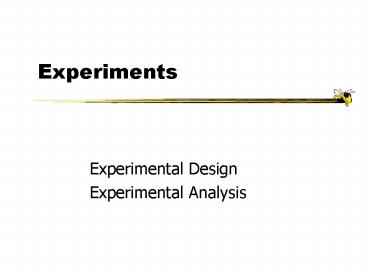Experiments - PowerPoint PPT Presentation
1 / 21
Title:
Experiments
Description:
Experimental Methodology. Variables - facets or attributes of study that can vary ... Experimental Designs. 1. Within Subjects ... Experimental Results ... – PowerPoint PPT presentation
Number of Views:18
Avg rating:3.0/5.0
Title: Experiments
1
Experiments
- Experimental Design
- Experimental Analysis
2
Agenda
- Experimental design
- Variables
- Methods
- Results
3
Experiments
- Utilize classical scientific method of
hypothesis, experiment and analysis - Key is methodology
4
Experimental Methodology
- Variables - facets or attributes of study that
can vary - We want to control all variables but the ones
were testing
subject experience gender
interface 1 vs. interface 2 lighting
intelligence location color vs. b/w
etc.
5
Control
- Two methods of achieving it
- Dont allow it to vary
- Make subjects/attributes as representative of
population as possible - In both mean and range
- Often, second method is all you can do
6
Types of Variables
- Participants are a random variable
- In experiment, we have independent and
dependent variables - Independent - What youre studying, what you
intentionally vary (eg, interface feature) - Dependent - What the study produces and you
tabulate, measure or examine (eg, time, number of
errors)
7
Example
- Do people complete operations faster with a
black-and-white display or a color one? - Independent - color or b/w
- Dependent - time it takes to complete
8
Experimental Designs
- 1. Within Subjects
- Every participant provides a score for all levels
or conditions
Color
B/W P1 12 secs. 17
secs. P2 19 secs. 15
secs. P3 13 secs. 21
secs. ...
9
Experimental Designs
- 2. Between Subjects
- Each participant provides results for only one
condition
Color B/W P1 12 secs.
P2 17 secs. P7 19 secs. P5
15 secs. P3 13 secs. P8 21 secs. ...
10
Which to Use?
- What are the advantages and disadvantages of the
two techniques?
11
Within Advantages
- Within subjects gives you more relative
information - Each person is their own control - Need bigger number of participants in between
subjects to average it out better
12
Between Advantages
- Within subjects tests are much more liable to
ordering effects - Participant may learn from first condition
- Fatigue may make second performance worse
- Balance!
- Half go first in one condition, half go first in
other
13
Experimental Results
- How does one know if an experiments results mean
anything or confirm any beliefs? - Example 20 people participated,
- 11 preferred interface 1,
- 9 preferred interface 2
- What do you conclude?
14
Statistics
- Central Limit Theorem
- The Sum of N random variables with the same
distribution is Normally Distributed - The Bell curve
15
Normal Distribution
- Occurs in many natural processes
- Grades
- IQ Scores
- Abilities of various kinds
- Typically observed in UI experiments
16
Normal Distribution
- Can use this knowledge to compute how probable
some particular set of observations is - Eg. If group A takes 10 seconds and group B takes
15 on average - Are A B different?
17
Hypothesis Testing
- In experiment, we set up a null hypothesis to
check - Basically, it says that what occurred was simply
because of chance - For example, any participant has an equal chance
of preferring interface 1 over interface 2
18
Hypothesis Testing
- If probability result happened by chance is low,
then your results are said to be significant - Statistical measures of significance levels
- p lt 0.05 often used
- Less than 5 probability it occurred by chance
19
Example
Experiment 1 Group 1 Group 2 Mean 7
Mean 10 1,10,10 3,6,21
Experiment 2 Group 1 Group 2 Mean 7
Mean 10 6,7,8 8,11,11
20
Errors
- Errors do occur
- Types
- Type I/False positive - You conclude there is a
difference, when in fact there isnt - Type II/False negative - You conclude there is no
different when there is
21
Presentation Techniques
Middle 50
Time In Secs
low
high
Mean
0
20
Age































